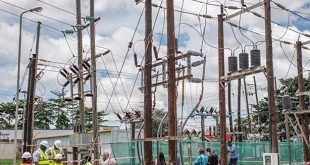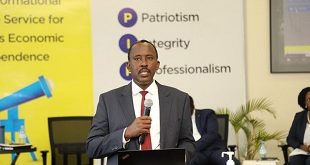
By Flavia Nassaka
With digital television, one is spoilt for choice. As a result, TV lovers keep toggling their remotes looking for interesting programmes on the different channels. On one of my favorite local channels, they are airing an unusual advert. It starts like an adventure film of a historical drama. Actually, it’s a youthful President Yoweri Museveni swearing-in for the first time as president of Uganda. It was on January 29, 1986 three days after his National Resistance Army (NRM) captured power and this ceremony witnessed by jubilant Ugandans was held on the steps of parliament building. January 26 has since been made a national holiday – NRM Liberation Day. This year’s celebrations are being held at the St. Leos’ College Kyegobe Grounds in the western Uganda town of Fort Portal under the theme, “30 years of NRM’s Committed Stewardship: A remarkable Legacy of Uganda”.
Having inherited a country in a sorry state where most social services were left broken down by the endless civil wars, Museveni promised not just a mere change of guards but a fundamental change. The fact that the 30 years anniversary comes amidst a heated campaign season where the 71-year old president is seeking fifth elective term, it looks like a good point to assess the status of social services especially education and health for the last three decades.In his manifesto, Museveni lists a number of roads that have been constructed by his government and 25 others which are currently under construction or being rehabilitated. He says when he came to power in 1986 only 1000 Kms of all roads were tarmac but now boasts of 4200 Kms. He also highlights a number of reforms in the education sector like free education for all provided through programmes like Universal Primary Education (UPE), Uganda Secondary Education (USE) and Universal Post Primary Education Training (UPPET).

Such programmes according to Fagil Mandy, an Education Expert have not only increased access to education but have also increased literacy levels. For instance by end of 2014, enrollment for primary school stood at 8.4 million yet for secondary 1.2 million from 124,000 in 1986. University graduates also increased from 5,400 per year from one university to more than 30 accredited universities producing over 150,000 graduates per year.
Also, When UPE was introduced in 1997, the number of pupils enrolling jumped from 2.5 to 7.5 million in 2008, reaching a level of 82% of eligible pupils being enrolled. Furthermore, the introduction of USE and UPPET in 2007 increased secondary education enrollment by 25% from 814,087 in 2006 to 1,088,744 in 2008.
Quality ignored
Currently, however, though the NRM government has worked on improving access to education by constructing more schools and creating a favourable environment for private individuals to invest in schools, the biggest challenge remains the quality of education and finding jobs after attending school. Poor quality and the lack of employable skills among school leavers is a problem the NRM Deputy Spokesperson, Ofwono Opondo, easily recognises.
“It’s better to have unemployed literates than having an uneducated population,” he said while appearing on a talk show on one of the local TV channels. Such attempts to rationalize it, however, mask what observers say is a lack of resolve to address the problem.As a result, many studies continue to show Uganda’s education outcomes trailing in the East African region where Uganda is a major education exporter. Research done by UWEZO, a program of TWAWEZA in 2015 found that only 20% of the pupils in their third year of primary school are able to read and do basic mathematics.Mandy says this problem is brought about by the way of the education system is structured. “The system is read, cram, pass, forget,” he says, adding that this needs to change.
“Which type of worker can such produce?” he says, “It doesn’t train the body, the mind and spirit.”
In his view, the effects of poor education carry through to working life of graduates and is the reason several studies, including one by the World Bank, have found the productivity of Ugandan workers to be low.
Uganda National Teachers’ Union (UNATU)’s James Tweheyo agrees. In an earlier interview, he told The Independent that the NRM government has had challenges in developing the right curriculum and also putting in place policies that can improve the education cycle outcomes at all levels.
For him, this challenge still exists because the ministry is not sensitizing and involving other players in policy formulation. He cites that the last five years of NRM have been the worst for the education sector with increased teacher dropout just because the teachers and top officials are bickering.
“They aimed at solving the numbers problem without planning progressively,” he says.Mandy tracks the changes in the education sector from 1989 to 1992 when the government put in place the Prof. Sentezza Kajubi commission which translated into the Education White Paper stipulating the goals of education. He says the white paper defined the sort of product to expect from the education cycle; for instance, producing a wealth generating citizen and an individual who believes in unity, independence and interdependence. But this only remained on paper.
 Also, even with increased advocacy for science courses, students enrolling for science and technology courses at the university are below the recommended 40% minimum requirement in areas of applied science and technology disciplines for rapid and accelerated economic growth and effective contribution in the global knowledge based economy.
Also, even with increased advocacy for science courses, students enrolling for science and technology courses at the university are below the recommended 40% minimum requirement in areas of applied science and technology disciplines for rapid and accelerated economic growth and effective contribution in the global knowledge based economy.
The Uganda National Council for Higher Education (UNCHE) report 2013 indicates that 70% of students who apply for university education enroll in arts courses. Mandy says what needs to be done is redefining the kind of Ugandan we want after various levels of education; for instance, by setting out what competencies to look out for in a learner after Ordinary level or Primary school. He says the lack of this definition makes the education produce “all kinds of graduates”.
For him, issues like mental work, physical education should be a prerequisite because they sharpen an individual by strengthening both the body and the mind.
Health
When you ask any official about how the status of health has changed, many are always quick to count the number of health facilities. They are indeed many, unlike in 1986 when patients would flood the few, mainly government-run, health facilities available then.
At the time, Uganda had a population of 15 million people. Today, the population has shot to 35 million and, although the number of health facilities has swollen to 4,722, they barely satisfy the demand.
Sarah Opendi, the Minister of State for Primary Health Care told The Independent that the government plans to construct more health center IIIs in about 120 sub-counties. Currently, 77% of Ugandans live within 5 kms from the health facility.
But even with this free treatment policy in place Ministry of Health 2013 figures indicate that individuals bear the biggest cost of health care constituting 43%, donors contribute 34% and the government 23%.
Opendi also has other sweet statistics. She says maternal mortality has reduced from 670 to 360 per 100,000 live births which is so because 44% of the mothers are delivered by trained medical workers. Infant mortality stands at 54 per 1000 births from 122 yet child mortality has reduced from 160 per 1000 to 57. These figures she attributes to increased coverage of immunisation services with 90% of the population receiving them. To counter the deadly HIV/AIDS, Opendi says for the last 30 years, the government has been working to reduce HIV infections rates that had hit the country in the early days of the Museveni’s government. She says although Uganda is still listed among the countries with the highest number of HIV/ AIDS infection prevalence rate at 7.3%, some strides have been made to enroll people on treatment.
But even with these advancements in health under the NRM government, Grace Kiwanuka, the Executive Director of Uganda HealthCare Federation describes Uganda’s health sector as “a fragile seedling with desperate need for protection from the elements and support of the stem in an aggressive and unrelenting storm”.
To Kiwanuka, the government has failed to retain its human resource with a lot of brain drain mainly because of low remuneration. She says the public health sector needs increased financing from the current 8.4% of public financing. Without an increase, she warns, the doctor to patient ratio will remain at 1:150,000, which is way below the recommended World Health Organisation (WHO) ratio of 1:10,000 for Africa.While she applauds the government for allowing private and public sector to work hand in hand, she says this relationship has not been utilized to enable access to quality services.
To her, all that NRM has done in the last 30 years is putting the foundation in place.
If they get a chance of popping back after Feb.18, she says, “The next chapter will probably define their legacy”. As it is now, the government is not only being criticized for presiding over gross corruption but for destroying the public trust in public services whereby quality healthcare and education for all have been turned into a private service for a few who can part with some cash.
 The Independent Uganda: You get the Truth we Pay the Price
The Independent Uganda: You get the Truth we Pay the Price


